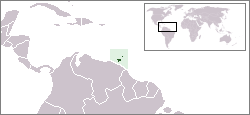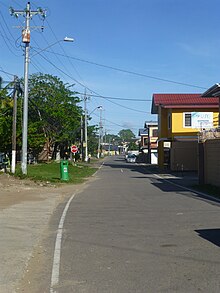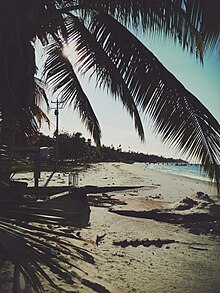
Trinidad and Tobago is an archipelagic republic in the southern Caribbean between the Caribbean Sea and the North Atlantic Ocean, northeast of Venezuela. They are southeasterly islands of the Lesser Antilles, Monos, Huevos, Gaspar Grande, Little Tobago, and St. Giles Island. Trinidad is 11 km (6.8 mi) off the northeast coast of Venezuela and 130 km (81 mi) south of the Grenadines. The island measures 4,768 km2 (1,841 sq mi) in area with an average length of 80 km (50 mi) and an average width of 59 km (37 mi). The island appears rectangular in shape with three projecting peninsular corners. Tobago is 30 km (19 mi) northeast of Trinidad and measures about 298 km2 (115 sq mi) in area, or 5.8% of the country's area, 41 km (25.5 mi) in length and 12 km (7.5 mi) at its greatest width. The island is cigar-shaped in appearance, with a northeast–southwest alignment.

Port of Spain, officially the City of Port of Spain, is the capital of Trinidad and Tobago and the third largest municipality, after Chaguanas and San Fernando. The city has a municipal population of 49,867 (2017), an urban population of 81,142 and a transient daily population of 250,000. It is located on the Gulf of Paria, on the northwest coast of the island of Trinidad and is part of a larger conurbation stretching from Chaguaramas in the west to Arima in the east with an estimated population of 600,000.

Tobago is an island and ward within the Republic of Trinidad and Tobago. It is located 35 kilometres (22 mi) northeast of the larger island of Trinidad and about 160 kilometres (99 mi) off the northeastern coast of Venezuela. It lies to the southeast of Grenada and southwest of Barbados.

Trinidad and Tobago cuisine is influenced by Indian-South Asian, West African, Creole, European, American, Chinese, Amerindian, and Latin American culinary styles.

The Borough of Chaguanas is the largest municipality and fastest-growing town in Trinidad and Tobago. Located in west-central Trinidad, south of Port of Spain, north of Couva and San Fernando, and named after the indigenous tribe who originally settled there, it grew in size due to its proximity to the Woodford Lodge sugar refinery. It remained a minor town until the 1980s when it began to grow rapidly as it drew people for its bargain shopping and moderately priced housing. Its rapid growth has seen property values increase dramatically, however.

The Panyols are a pardo or moreno (tri-racial) ethnic group in Trinidad and Tobago of Afro-Spanish-Indigenous descent, primarily of mixed South American Amerindian, Trinidad and Tobago Amerindian, Afro-Trinidadian, Afro-Venezuelans and Spanish descent. The name is a derivation of the word 'español', as well as the community's settlement in what became predominantly cocoa cultivated regions of Trinidad. Also referred to as Pagnols or Payols, the panyol communities draw cultural influence from both sides of the Gulf of Paria, and are predominantly found within the Northern Range rainforest mountains and valleys of Trinidad, with South American cultural influences most predominantly derived from regions around the Orinoco, and Caura River, Venezuela.

Trinidad and Tobago is divided into seven regions, five boroughs, two city corporations and one ward.
Couva is a town in west-central Trinidad, south of Port of Spain and Chaguanas and north of San Fernando and Point Fortin. It is the capital and main urban centre of Couva–Tabaquite–Talparo, and the Greater Couva area includes the Point Lisas industrial estate and the port of Point Lisas. It is one of the fastest-growing towns in the country. Couva's southern boundary is at the village of California and Point Lisas, and to the north Couva stretches to McBean. To the east of Couva is Preysal. To the west of Couva is the road to Waterloo and Carli Bay, which are located on the Gulf of Paria. Couva was part of the Caroni County. Couva is considered a major power base for the United National Congress, whose headquarters was previously located here.
Icacos Point is the southwesternmost point in Trinidad and Tobago. It is at the end of a long peninsula that forms Saint Patrick County. A channel called the Serpent's Mouth separates Icacos Point from the coast of Venezuela, only 11 kilometers away. A good image of the Serpent's mouth is seen in Travelling Luck's link which provides additional detail on the area "Although Icacos is referred to as a Point which suggests a narrow piece of land, parts of the area are also been referred to as a village in Teneil Nurse's blog where Ms Nurse writes on the history of Icacos.

Diego Martin is a Borough of Trinidad and Tobago. The region has a land area of 127.53 km2. Urban areas within the region include Carenage, Diego Martin, Maraval and parts of Saint James. The local government body is the Diego Martin Borough Corporation.

The Borough of Siparia is the fifth and newest Borough of the Republic of Trinidad and Tobago, located in the southwestern portion of the island, it is Trinidad and Tobago's southernmost borough. The Siparia Borough Corporation is headquartered in Siparia proper (downtown). Other urban areas include Cedros, Fyzabad, La Brea, Santa Flora, South Oropouche.

Saint James is a district of Port of Spain, Trinidad and Tobago. Port of Spain's last major municipal expansion occurred in 1938, when the St. James district north of Woodbrook and west of St. Clair was incorporated into the city limits. In the late 19th century, Indian indentured labourers on nearby sugar estates established houses here, and St. James gradually became the centre of Port of Spain's Indian population, with many streets named after cities and districts in British India. Western Main Road, the area's major thoroughfare, has long been the city's main nightlife district, sometimes nicknamed "the city that never sleeps".

The Southern Main Road is a major road in Trinidad and Tobago running from Curepe in the north through Chaguanas, Couva, San Fernando, and Point Fortin to Icacos in the southwest, over a now discontinuous length of 120 km.
Lopinot is a village in Trinidad and Tobago.
China plays an increasing important role of economic and developmental importance in the region and the relations with China have increased steadily over time. The Caribbean's relations with China, are largely defined as either: the People's Republic of China or the Republic of China. As of 2024, nine states in the Caribbean recognized the PRC and four recognized the ROC.
The National Library and Information System of Trinidad and Tobago is a corporate body established by the NALIS Act No. 18 of 1998 to administer the development and coordination of library and information services in Trinidad and Tobago.

The following outline is provided as an overview of and topical guide to Trinidad and Tobago:
Prostitution in Trinidad and Tobago is legal but related activities such as brothel keeping, soliciting and pimping are illegal.
Soldado Rock or Soldier's Rock, formerly known as Soldado Island, is a small island in the Republic of Trinidad and Tobago. It is located in the Gulf of Paria 10 km off Icacos Point in Trinidad and north of the Venezuelan mainland. The island was originally a possession of the Venezuelan government, but became part of the territory of Trinidad and Tobago in 1942. The island is a wildlife sanctuary since being declared in 1934.
Ortoire is a village in Mayaro County on Trinidad Island. It is named after the adjacent Ortoire River. The village dates to at least the 1880s or a few decades earlier. Ortoire is just west of the peninsula of Point Radix, named after a French immigrant granted an estate there in 1783. The village's beach at the mouth of the river provides shelter to ocean-going fishing boats. The village was not listed in the 1901 census, but was believed to have "a few hundred people" then. The village is within the Ortoire Municipal Corporation, a political subdivision of the Mayaro–Rio Claro Regional Corporation, a political region of Trinidad and Tobago that replaced the historical county of Mayaro in 1991. The Ortoire Municipal Corporation includes the Point Radix peninsula and is bounded by Mafeking on the west, St. Joseph Village on the south, and the Atlantic Ocean on the east and north.















